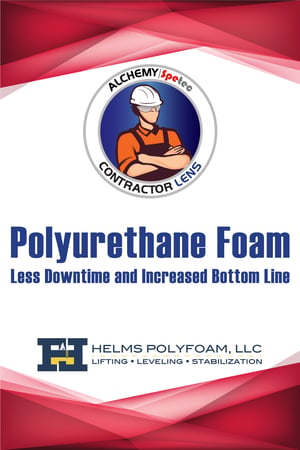
 This post is part of the Alchemy-Spetec Contractor Lens series, featuring views, news & case studies written by our customers. This article, written by J.R. Crowell of Helms Polyfoam, explains why polyurethane slab lifting requires less downtime than alternative repair solutions (and why that's an advantage for property owners & managers). If you're an Alchemy-Spetec customer and you'd like to discuss writing content for our blog, please send an email to marketing@alchemy-spetec today!
This post is part of the Alchemy-Spetec Contractor Lens series, featuring views, news & case studies written by our customers. This article, written by J.R. Crowell of Helms Polyfoam, explains why polyurethane slab lifting requires less downtime than alternative repair solutions (and why that's an advantage for property owners & managers). If you're an Alchemy-Spetec customer and you'd like to discuss writing content for our blog, please send an email to marketing@alchemy-spetec today!
When deciding on a repair plan for a commercial facility, no matter the type of repair, one very important factor to consider is downtime. That old expression “time is money” is not a joke, especially when we are talking about downtime for a business.
A large portion of repairs in the commercial market, whether it be concrete lifting, soil stabilization, or void fill, are in areas with high traffic. This traffic usually consists of forklifts, heavy equipment, and semi-truck and trailers, all of which have a dollar amount tied to their load or run time. Every minute they are aren’t running is a minute they 1) are not making money or 2) are losing money on a late delivery or late project completion.
How is Polyurethane Foam Beneficial to Downtime?
Small Footprint:
Polyurethane repairs generally require only one truck or trailer or even smaller equipment. Crews can work around high traffic areas and times to ensure that daily workflow is minimally impacted.
No Excavation:
Repairs are completed using polyurethane resins injected through a 3/8” – 5/8” hole. These injections are completed from the equipment mentioned above, requiring no heavy equipment. No heavy equipment means that employees will not have to alter their site flow to navigate around a large excavator or concrete truck.
Fast Cure Time:
When it comes to concrete lifting, polyurethane resins begin to set up within 15 seconds after injection and are 90% cured within 30 minutes. This means that by the time the crew leaves the site, the treated areas are ready for “business as usual” and can allow normal traffic. Compare this to demolition and concrete pouring (days of labor and curing), and you see a huge savings on downtime.
If time truly equals money, and we all know it does, the above three reasons show how a polyurethane repair can keep downtime to a minimum and maintain an efficient workflow, thus keeping the bottom line in order. When comparing estimates of various repair methods, don’t get stuck on the dollar figure, always compare the total repair plan and what it could cost on the back end.



